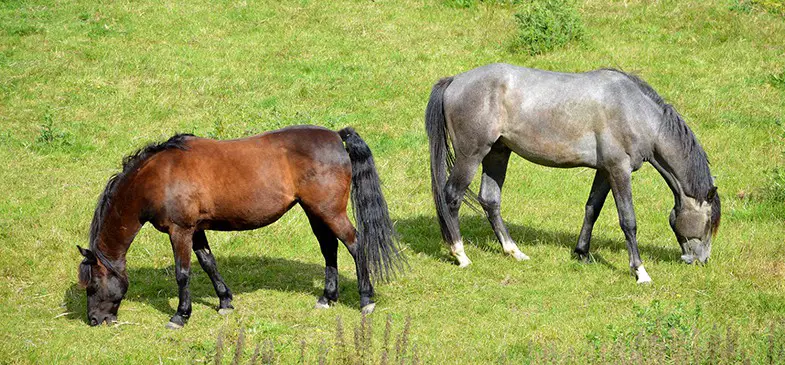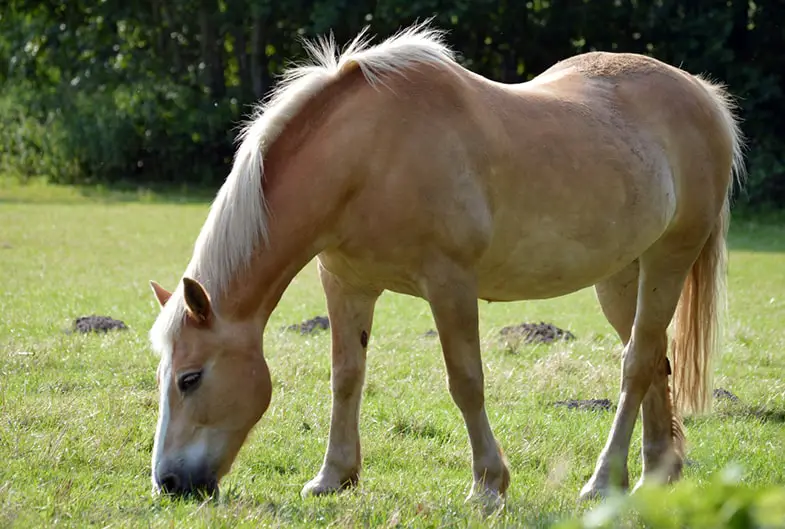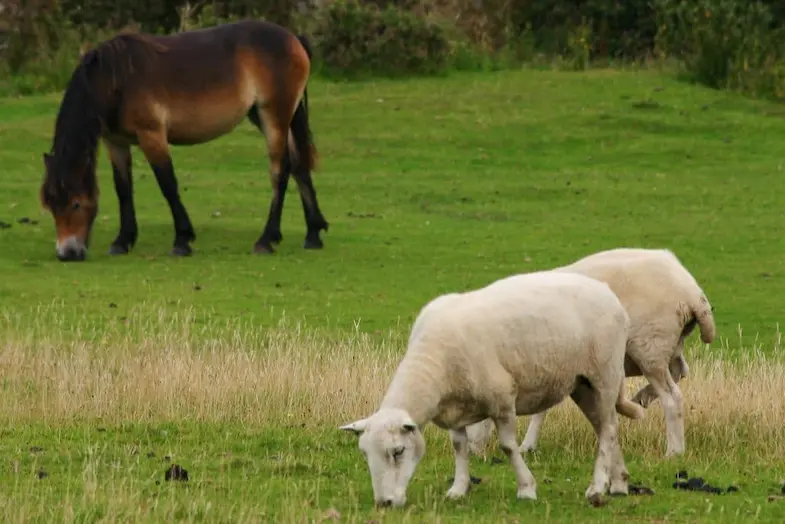Most horse owners know that worms can be a serious problem for horses, causing a range of problems but if you’re new to horses or have never owned one before it can be difficult to know what to look out for and when to deworm a horse. This is why I decided to write this article, I wanted to create a helpful reference that both first-time and seasoned owners would benefit from.
How do I know if my horse needs worming? Common signs of a worm infestation in horses include fatigue, loss of appetite, diarrhea, weight loss, a dull-looking coat, as well as sores, and a loss of hair around the tail area due to the horse constantly rubbing itself in order to relieve the itching.
What are the signs of worm infections in horses?
Horses can be infected with a number of different worms and the symptoms will vary depending on the type of worm but there are a few common signs to look out for:
- Poor or loss of appetite
- Diarrhea
- Weight loss
- Hair loss (especially around the tail and anus)
- Anemia
- Lethargic
- Colic
- Impaction
- Loss of condition (such as a dull coat)
- Sores around the rump
Please note: In some severe cases, there may also be blood in your horse’s manure, although if this is the case don’t just presume it’s worms. It could be a sign of something more serious and you should speak to your vet for advice.
What types of worms can horses get?
There are a number of different worms that can infect horses, as well as cause a range of different symptoms, but the most common ones are:
Redworms (strongyles)
There are two different types of redworms, large strongyles, and small strongyles, although they can both be serious because they feed on the horse’s blood. Horses become infected when they ingest the larva as they graze, the larvae make their way to the intestine where they, after maturing, lay their own eggs. As you can imagine these eggs then ‘leave’ the horse in its manure and will then wait for another grazing horse to come past and start the process off again.
Large strongyles can be very dangerous because it can take them six months to work their way through the horse’s digestive system, ingesting blood as they go, often causing anemia. This can lead to blocked arteries and the transmission of viruses.
Symptoms of a large strongyles infestation can include weakness and fatigue, loss of weight, colic, and diarrhea.
Small strongyles are smaller than large strongyles but can often be more serious, in part because they can live in the horse for three years and can develop an immunity to dewormers. The larva will attach itself to the wall of the intestine and cecum (the first part of the large intestine) and then produce a protective coat around itself to protect against dewormers. Once they’ve attached themselves to the intestine they’ll stay they for around years, eating the gut lining while they’re there. When they mature they’ll leave the protective layer and lay their own eggs which will go on to start the cycle again.
Like large strongyles, horses can become weak and tired if they have small strongyles parasites. The eggs can often leave the horse in such large numbers that the horse suffers from diarrhea, colic, and some extreme cases can even die.
Roundworms (ascarids)
Once they’ve been ingested, roundworm larva makes their way to the small intestine where they’ll grow and then migrate through the liver to the lungs and then the throat before being swallowed again. When they’re back in the small intestine they mature and reproduce. This can be a real problem in horses that are under a year old because they haven’t developed an immunity to them yet.
Common symptoms of a roundworm infestation include coughing, lung damage, poor development (in young horses), colic, and in extreme cases death.
Tapeworms
The eggs of tapeworms are eaten by mites who then inadvertently incubate the eggs as they develop into larvae. While grazing, horses will eat the mites which allows the larvae to mature. Once they’ve matured they attach themselves to the wall of the gut where they can cause obstruction and inflammation and ultimately impaction.
Symptoms can include anemia, weight loss, ulcers, and even colic.
Bots
Adult bot flies lay yellow-colored eggs on the chest, shoulders, and forelegs of horses, as the horse grooms itself it ingests the eggs which then attach themselves to the stomach lining causing irritation and digestive problems. Around 9 months later the larvae leave the horse via droppings and burrow into the ground to mature, only to return as adults and repeat the cycle.
Horses with a bot infestation can suffer from colic, ulcers, and lesions.
Pinworms
Female pinworms lay their eggs on the skin around a horse’s anus which makes the area extremely sore and causes the horse to itch that area profusely as they’re trying to get some relief. Although they don’t often cause any internal harm they can irritate the skin so much that the horse can rub the area raw.
Lungworms
Often present in horses who share a paddock with donkeys (although donkeys will show no signs of an infestation), lungworm larvae are ingested by the horse and then make their way through the digestive tract into the bloodstream. The eventual destination is the respiratory system where they can cause breathing difficulties for the horse.
Symptoms of a lungworm infestation can include coughing, an increased respiratory rate, weakness, depression, and loss of appetite. Sadly, if left untreated, it can be fatal to foals.
| Weak / Fatigue | Weight loss | Cough | Breathing issues | Loss of appetite | Colic | Diarrhea | Other | |
|---|---|---|---|---|---|---|---|---|
| Large strongyles | ✔ | ✔ | ✔ | ✔ | Anemia | |||
| Small strongyles | ✔ | ✔ | ✔ | |||||
| Roundworm | ✔ | ✔ | ✔ | |||||
| Tapeworm | ✔ | ✔ | Anemia Ulcers | |||||
| Bots | ✔ | Ulcers Lesions | ||||||
| Pinworm | Hair loss Sores | |||||||
| Lungworm | ✔ | ✔ | ✔ | Depression |
How do horses get worms?
The most common way of horses get worms is by grazing contaminated soil or grass or by drinking contaminated water. Horseflies and other insects can also cause horses to get worms when they either bite the horse or lay their eggs on it.
Eggs that passed through the horse wouldn’t be a problem, however, the issue arises when they grow into larvae and then mature. At this stage, they’re able to affect the horse’s immune system as well as interrupt their ability to get the right amount of nutrients from their food. While this obviously isn’t a good thing, in young or old horses this can cause severe and permanent damage.
The problem with worms though is that it can often be a never-ending cycle. The parasite lays its eggs which grow into larvae and are ingested by horses, the larvae then mature and lay their own eggs before passing through the horse in the form of manure which then contaminates the grass. The horse then eats the grass and the cycle goes on.
How often should you deworm your horse?
Until very recently the general consensus was that you should deworm your horse every 6-8 weeks. While this is still recommended in some cases it’s not always a good idea. Like most bacteria, parasites have also started to develop a resistance to treatments which is why it’s better to have your horse tested for worms first.
There are two main ways to tell if your horse has an infestation of worms. All horses will have some worms in their digestive system and you don’t want to completely remove all worms so testing to see if the worms are a problem is a good idea.
You can use the fecal egg count method to count the number of eggs your horse has per gram of droppings (known as EPG – eggs per gram). The baseline for deworming is anything over 200 EPG. The problem with this method though is that only adults lay eggs so if your horse has a large number of larvae but only a very small number of adults the count won’t be reliable.
The other way of testing for worms is to use a tapeworm antibody test. This is a blood test carried out by a vet. The problem with this method though is that the results can still be positive for up to six months after all of the tapeworms have been killed.
To help prevent resistance it’s advisable to have a natural method for reducing the number of larvae while also only deworming horses that have a large number of eggs. In the long run, this will not only be cheaper but it’ll also help to increase the effectiveness of dewormers.
How do you treat horses for worms?
The best way to treat worms is to use a deworming paste but which paste you use will be dependent on the type of parasite your horse has a problem with. It’s also worth mentioning that not all worms are common all year round, some are prevalent at different times of the year which is why you should use the correct dewormer.
Different dewormers target different worms so you might find that the dewormer you used last time doesn’t work this time. Regularly change your dewormer regularly otherwise worms can start to develop an immunity to it,
What can I do to control worm infestations?
In recent years parasites have increased their resistance to anthelmintics (the active ingredient in deworming products) so many people opt to reduce or even prevent the risk of worms instead of deworming. This might sound impossible but is actually easier (and more effective) than you might think.
- Remove droppings every day – If you clear droppings from the paddock every day it’ll prevent larvae from hatching and then being ingested by your horse while he’s grazing. As an added bonus this will help to reduce the number of flies in the summer as well.
- Use a hay net or rack – Feeding hay off of the ground will help to keep it free from larvae.
- Fecal egg count (or FEC) – Some horses will carry more eggs than others. Counting the number of eggs in each horse’s droppings will help to establish which horses need to be dewormed and which don’t. Deworming only those horses will not only help to reduce the chance of infection it’ll also increase the effectiveness of the dewormer. Horses with 200 or more eggs per gram (EPG) are considered to have a large number and need deworming. A recent survey discovered that around 90% of fecal egg counts were below 200 EPG, so, therefore, didn’t need deworming.
- Rotate paddocks – If you have access to more than one paddock try to switch which one you use regularly, every 3-6 months is fine. Doing this means that most of the larvae will be killed off by the extremes of temperatures during the summer and winter. If you only have one paddock then consider fencing half of it off and then rotating between the two halves.
- Cross grazing – Sharing a paddock with sheep or chickens will drastically help to reduce the number of larvae. This is because both sheep and chickens can eat the horse worm larvae without becoming effect themselves.
Can worms be good for my horse?
Historically we’ve tried to eradicate worms by use of a strict deworming program but can worms actually be a good thing? I know you think I’ve gone mad but there’s a lot of evidence to show that a small number of worms can actually be a good thing. A low fecal egg count (approximately 100 to 200 EPG) can in fact help your horse. This is because they help to strengthen your horse’s immunity which is obviously a good thing.
Conclusion
You don’t have to religiously deworm your horse every few months, in fact doing so can lead to the parasites becoming immune to the treatment. Instead, it’s better to have a worm management plan where you regularly test for worms and then treat them accordingly. At the same time as doing this, you should be keeping the paddock as free of droppings as possible and rotate paddocks at least every six months.
I hope you found this article helpful. If you did I’d be grateful if you could share it please as it would really help me.
Recommended products
Over the years I have tried hundreds of different horsey products, from various blankets and halters to different treats. Some I’ve loved, others I’ve hated but I thought I’d share with you my top all-time favorite products, the ones I never leave the yard without. I’ve included links to the products (which are in no particular order) that I really think are great.
- Horse Knots by Reference Ready – If you’re like me and enjoy pocket reference guides then you’ll love this knot tying guide. These handy cards can easily fit in your pocket or attach to the saddle for quick reference. They’re waterproof, durable and are color coded to make them easy to follow.
- Mane ’n Tail Detangler – Even if you never show your horse you’ll need to detangle his tail from time to time (and possibly his mane too) which is always a challenging chore! I’ve found that if I run a little bit of detangler through my horse’s tails every few days it stops them from getting matted up and makes combing them easy, even if they’re coated in mud. I don’t know if I should admit to this or not but it also works wonders on my hair.
- TAKEKIT Pro clippers – Over the years I’ve tried a lot of different clippers and while some were obviously better than others I found these to be by far the best. They are heavier than a lot of other clippers but for me, that’s a good thing, it makes them feel more sturdy and hardwearing. On top of that they have a range of speeds so are just as good for clipping your horse’s back as they are his face. I also like the fact that they come in a handy carry case but that’s not for everybody. The company that makes them is super good and incredibly helpful too, a real bonus these days. The only thing I wasn’t keen on was the fact that it doesn’t come with any oil, but that’s not a major problem as it’s not difficult to buy lubricant.
- Shire’s ball feeder – There are so many boredom buster toys out there but I like to use these every day, regardless of whether or not my horses are bored. I find that it helps to encourage my horses to problem solve by rewarding them with treats (or pieces of fruit) but it also mimics their natural grazing behavior which helps to keep them calm and de-stressed.
- Horse safe mirror – This is a strange one that many people are surprised about but I like to put horse safe mirrors in the trailers as well as in the quarantine stalls. It helps to prevent the feeling of isolation by giving the impression of other horses being around. Being herd animals horses can get extremely stressed when they feel that they’re on their own but with these stick-on mirrors, they believe that at least one other horse is with them.
- Rectal thermometer – I know this isn’t glamourous at all but it’s vital for your horse’s well-being to be able to check their temperature and a rectal thermometer is the easiest way of doing this which is why I’ve added it to the list.
Shopping lists
I’ve also put together a few shopping lists of essential items that I’ve found helpful over the years. I’ve broken the lists down into different categories rather than put everything in one massive list 😉




